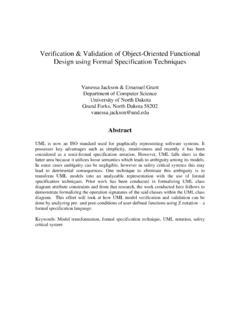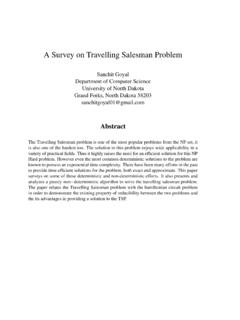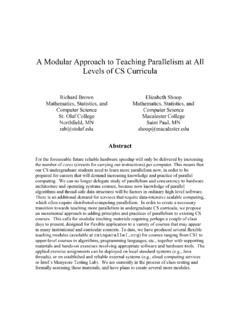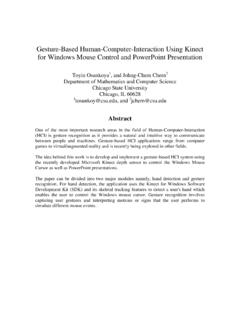Transcription of Introductory Programming using Processing
1 Introductory Programming using Processing Mark M. Meysenburg Information Science and Technology Department Doane College Crete, NE 68333. Abstract For the past two years, we have used the Processing Programming language to teach our Introductory Programming (CS1) course at Doane College. Processing [10] is a freely- available Programming language derived from Java. The language is designed to allow programmers to easily add graphics, animation, sound, and user interaction to their pro- grams. These characteristics make the language an excellent choice to teach during a first Programming course, particularly at a small liberal arts college.
2 This paper describes the philosophy of our course, details why we are using Processing , illustrates several concrete examples of assignments and projects we have used, and presents, subjectively, the impact teaching with Processing has had on our students. 1 Introduction For the past two years, we have used the Processing Programming language to teach our Introductory Programming (CS1) course at Doane College. Processing [10] is a freely- available Programming language derived from Java. The language is designed to allow programmers to easily add graphics, animation, sound, and user interaction to their pro- grams.
3 These characteristics make the language an excellent choice to teach during a first Programming course, particularly at a small liberal arts college. This paper describes the philosophy of our course, details why we are using Processing , illustrates several concrete examples of assignments and projects we have used, and presents, subjectively, the impact teaching with Processing has had on our students. 2 The Doane College CS1 Course Doane College is a small liberal arts college in Crete, Nebraska. Our Information Science and Technology department offers a Computer Science major, an Information Science ma- jor, a Computer Studies minor, and an Information Technology Teaching Endorsement.
4 Each of these starts with a four-course core sequence: IST 140 Introduction to Information Science and Technology, IST 145 Introduction to Programming and Problem Solving, IST 146 Programming and Problem Solving II, and IST 252 Principles of Digital Logic and Computer Organization. IST 145 is our CS1 course, where we introduce students to the fundamentals of computer Programming . Due to faculty constraints and student demand, only one section of IST 145. is offered each semester, and IST 145 is the only Introductory Programming course taught at Doane.
5 Further, IST 145 is a service course for the Mathematics and Physics depart- ments; their students must take IST 145 as a cognate for their majors. Since Doane is a liberal arts college, many of our CS / IS majors are also involved in humanities pursuits, such as art, music, or theater; computing is usually not their only passion. The internal and external constraints on our CS1 course, plus the characteristics of our liberal arts students, have influenced our decision to adopt Processing as the language for CS1, and also the method in which we teach Programming in the course.
6 To serve the needs of our CS / IS students, as well as the needs of students taking IST 145. as a cognate, we teach our course in a modified objects later manner, instead of objects first. For our purposes, we adopt the following definition of objects first, as proposed by Bailie, et al.: .. an objects first approach .. starts with classes and objects from the first day and introduces basic Programming constructs such as conditionals and loops as needed to solve specific problems. [3]. 1. A typical objects first CS1 course would include coverage of such topics as inheritance and polymorphism, perhaps at the expense of other fundamentals like selection or itera- tion.
7 Philosophically, we believe that teaching more advanced OO concepts early in CS1. would be very difficult, and even counter-productive, for our students. Even objects first proponents agree that teaching CS1 in this manner is challenging [5]. Our IST 145 course uses objects from early on, but pushes the writing of classes to the end of the course. We introduce the use of objects after mathematical operators and expressions, but before coverage of selection and iteration. The nature of Processing requires us to teach how to write methods early on, and so we teach how to write several of the built-in methods of Processing (such as the draw() method) in the same unit where objects are introduced.
8 We cover selection and iteration after the objects unit. Following iteration, we return to methods, and teach how to write non-built-in methods, including how to use a top-down design approach to create hierarchies of methods. Next, we teach single-dimensional ar- rays, and basic searching and sorting. Finally, we spend some time learning how to write user-defined classes. More advanced object-oriented design concepts, such as inheritance and polymorphism, are covered in our CS2 course, IST 146. We find that this approach serves our students well, given that not all of the students in IST 145 are destined to be CS / IS majors.
9 Students taking the course as a mathematics or physics cognate are more likely to require Programming to write scripts or short, one- off programs, rather than large, complicated software systems. If we taught the course in a more objects first manner, with emphasis on classes, polymorphism, inheritance, and so on, we would be cheating these students out of concepts they will find useful later. Further, we believe that it is beneficial for CS / IS students to have a firm grasp of selection, iteration, and procedural Programming concepts before moving into more fully realized coverage of object oriented Programming .
10 Throughout the IST 145 course, we attempt to emphasize problem solving skills over com- prehensive coverage of the details of the Programming language. Introductory program- ming students often have meager problem solving skills (see, for example, Beaubouef, et al. [4]), and so it is important to take such an approach. We employ a Recognize / Analyze /. Design / Implement / Support (RADIS) problem solving framework throughout the course. We perform thorough analysis and design steps for each of the examples we teach, employ- ing flowcharts, pseudocode, data dictionaries, and, for the writing classes unit, UML class diagrams.








